«He left the child in the thread.» Say what?

The other day, my friend posted a photo of on Facebook of himself eating a pastry, with the text, «Me salió el niño en la rosca.» My mother saw the photo and asked me, «What’s that post about – the one with the child and the thread?» My mother can’t read Spanish, so she was seeing the machine translation, which reads, «He left the child in the thread.» What it really means is: «I got the baby in the ‘King’s bread’.» This refers to the little plastic baby Jesus that is hidden in the traditional pastry eaten on the feast of the Epiphany in Mexico and in some other countries. Lesson: don’t trust machine translation! They are unable to interpret (or even less, explain) context and often fail to convey the meaning of even simple sentences. If you need a real translation, ask a professional.
Interesting articles I’ve translated for Aleteia.org
One of my regular clients for Spanish-English translations is the website Aleteia.org., which publishes Catholic news and spirituality articles. Many of the articles are the work of the site’s own team of authors and reporters (including one by me that started off as a simple translation of some words of Pope Francis); others are culled from other reliable Catholic web sources.
I’ve worked with them for over a year now and it’s always a pleasure to see something from Aleteia in my inbox – not just because it’s work (which is always a good thing), but because I enjoy the subject matter. I spent many years as a member of a Catholic religious community, working in and for the Church, and although my life and employment have changed, I still carry the Church in my blood. That makes translating Catholic news and spirituality often both enjoyable and enriching (and sometimes uncomfortable, in a good way – the message sometimes pushes me out of my comfort zone, as the Gospel should…). The most interesting of all nowadays is translating articles about Pope Francis, who never ceases both to challenge and surprise me.
If you’d like to read some interesting Catholic articles and get a taste of how I translate, here are some I find particularly interesting:
- A missionary nun’s insights into ISIS
- A priest saving children from human trafficking
- A difficult but formative experience in Pope Francis’ youth
- A candid interview with Pope Francis – a bit challenging to translate because of the informal and somewhat unstructured nature of a spontaneous conversation!
- 10 recommendations from St. Thomas Aquinas
- Testimony of someone who was conceived during rape and is grateful to her mother for not aborting her
If you need Spanish to English translations on any topic, contact me for a quote.
Diagramas para una segunda cruz de origami ahora disponibles
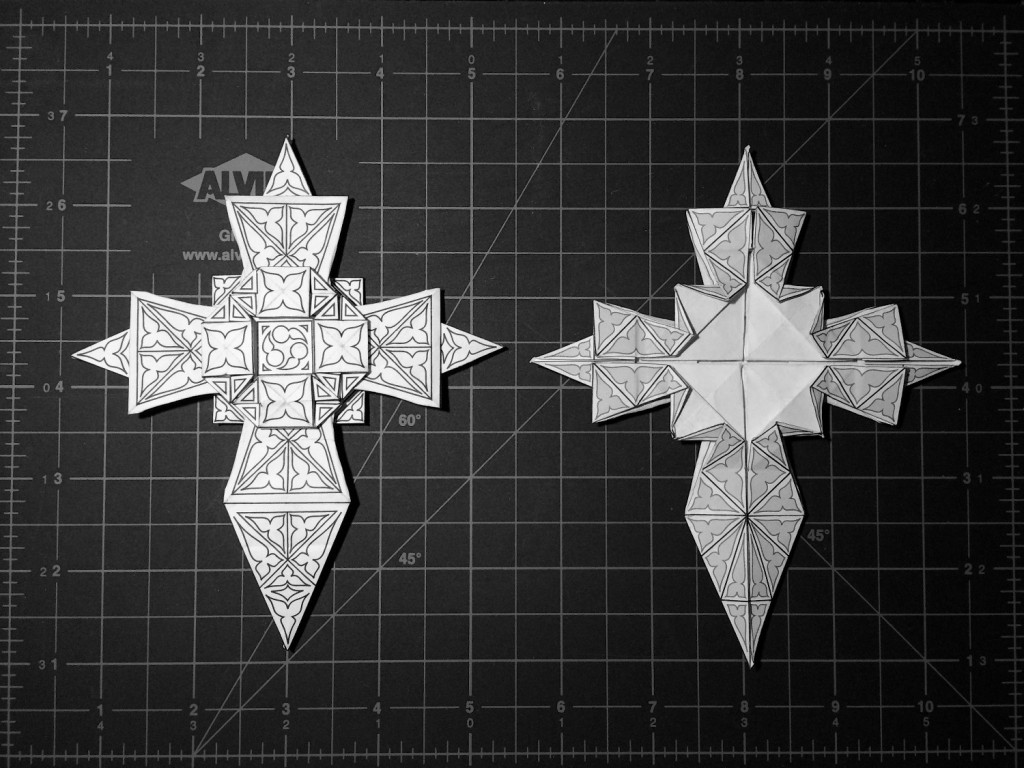
Esta cruz, la llamo «variación 2» porque es la segunda de varios diseños que he creado para doblar cruces de origami a partir de una misma base. El archivo incluye 5 páginas de diagramas y una página con papel que se puede recortar y usar para doblar esta cruz, como se ve en la foto arriba. Los diagramas explican dos variantes de esta cruz: una es más fácil, pero la otra se ve más «limpia» al final (ésta es la variante que se ve en la foto).
Las instrucciones escritas que acompañan los diagramas están en inglés y castellano.
Origami cross, variation 2: diagrams available

The diagrams and patterned paper for this cross are now available for purchase and download (for only $2.30) on the OrigamiUSA website. I call this one «Cross variation 2» because it’s the two of several crosses I designed using the same base. The file includes 5 pages of diagrams and one page with Gothic-inspired patterned paper you can print, trim to a square, and fold (as seen in the photo). It also includes two slightly different versions of this cross: one is slightly easier, but the other looks somewhat neater. (The one in the photo above is the neater but harder version.) Instructions are included in English and Spanish.
Click here to go to the product page on the OrigamiUSA store («The Source»)!
Diagramas para una cruz de origami, disponibles para descargar
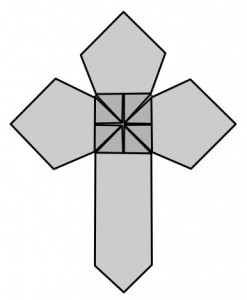
Ahora se pueden comprar y descargar del la tienda en línea de OrigamiUSA (por $2) diagramas para uno de tres diseños para una cruz de origami que enseñé durante la convención de OrigamiUSA en el verano de 2014. El archivo incluye 6 páginas de diagramas y una página con papel preparado con un tema gótico que se puede imprimir y recortar para doblar esta cruz. Los diagramas incluyen dos variaciones respecto a la forma de
los brazos de la cruz, y otras sugerencias para personalizar el diseño con otras alteraciones. Hay instrucciones escritas en inglés y castellano.
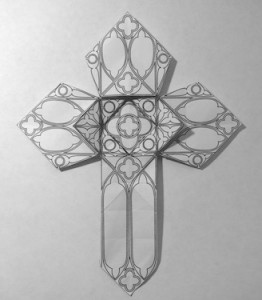 Espero subir dos otros diseños de cruces pronto; éste es el diseño más sencillo de los tres (por eso lo he titulado «variación 1»).
Espero subir dos otros diseños de cruces pronto; éste es el diseño más sencillo de los tres (por eso lo he titulado «variación 1»).
Haz Click aquí para ir a la página del producto en la tienda virtual de OrigamiUSA («The Source»)!
Origami cross diagrams now available for download
 Now available for purchase and download (for $2) from the OrigamiUSA web store is a file with diagrams for one of three origami cross designs I taught at the OrigamiUSA convention in the summer of 2014. The file includes 6 pages of diagrams and one page with Gothic-style patterned paper you can print and cut out to fold this cross. Included in the diagrams are two main variations regarding the shape of the arms of the cross, and other suggestions for how to personalize the design with other alterations. The text instructions are provided in English and Spanish.
Now available for purchase and download (for $2) from the OrigamiUSA web store is a file with diagrams for one of three origami cross designs I taught at the OrigamiUSA convention in the summer of 2014. The file includes 6 pages of diagrams and one page with Gothic-style patterned paper you can print and cut out to fold this cross. Included in the diagrams are two main variations regarding the shape of the arms of the cross, and other suggestions for how to personalize the design with other alterations. The text instructions are provided in English and Spanish.
 I hope to upload two more cross designs soon; this is the simplest of the three (hence the title, «variation 1»).
I hope to upload two more cross designs soon; this is the simplest of the three (hence the title, «variation 1»).
Click here to go to the product page on the OrigamiUSA store («The Source»)!
Combining translation with origami at the OrigamiUSA Convention 2014
The two main activities that I offer through Servimatices International are translations and origami. At the end of June, I had the opportunity to do both at the same time!

Whenever I can, I participate in OrigamiUSA’s annual convention, which is held in Manhattan. The event – which this year had more than 650 active participants (not including adults who were accompanying children) – includes classes, competitions, an exhibit (of extraordinary quality), and many opportunities to spend time and share origami with origami folders from all over the world. The special guests this year were evidence of the internationality of the event. One was Isa Klein, a Brazilian origami artist known especially for her modular designs and for her instructional videos; the other was Nick Robinson, origami teacher and prolific author of origami books, from the United Kingdom.

Words are not strictly necessary in order to share origami; it’s a very visual and tactile art, and there is a more or less uniform international system of symbols used in written diagrams. However, verbal communication does help, especially in classes with more than two or three people where not everyone can see up close what the teacher is doing. So this year, I decided to respond to the official petition for volunteer translators to interpret classes by teachers who don’t speak English.
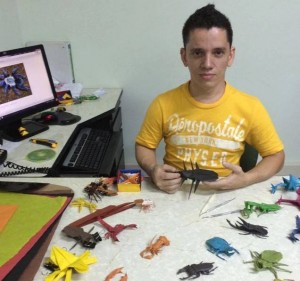
There were already two translators for Portuguese to English, so I didn’t have the pleasure of translating a class for Isa Klein, although I did get to have some nice conversations with her; as is usually the case, she is not only a talented origami artist, but also a very nice person. However, they needed someone to help with Spanish, so I ended up translating (technically, doing consecutive interpreting) for a class taught by Diego Becerra. Diego teaches origami at the University of St. Thomas in Bucaramanga, Colombia. Although he is mostly known for his (amazing) insect designs, the model he taught in the class I translated was a dragon. It was the first time in a few years that I have done real-time interpreting, but there weren’t any problems; on the contrary, it was great experience which I hope to repeat on other occasions! After all, I got to learn a new origami model and translate at the same time – what more could I ask for?
Here is a photo of the origami that Diego Becerra had in the exhibition, including several examples of the dragon that he taught in the class I translated:
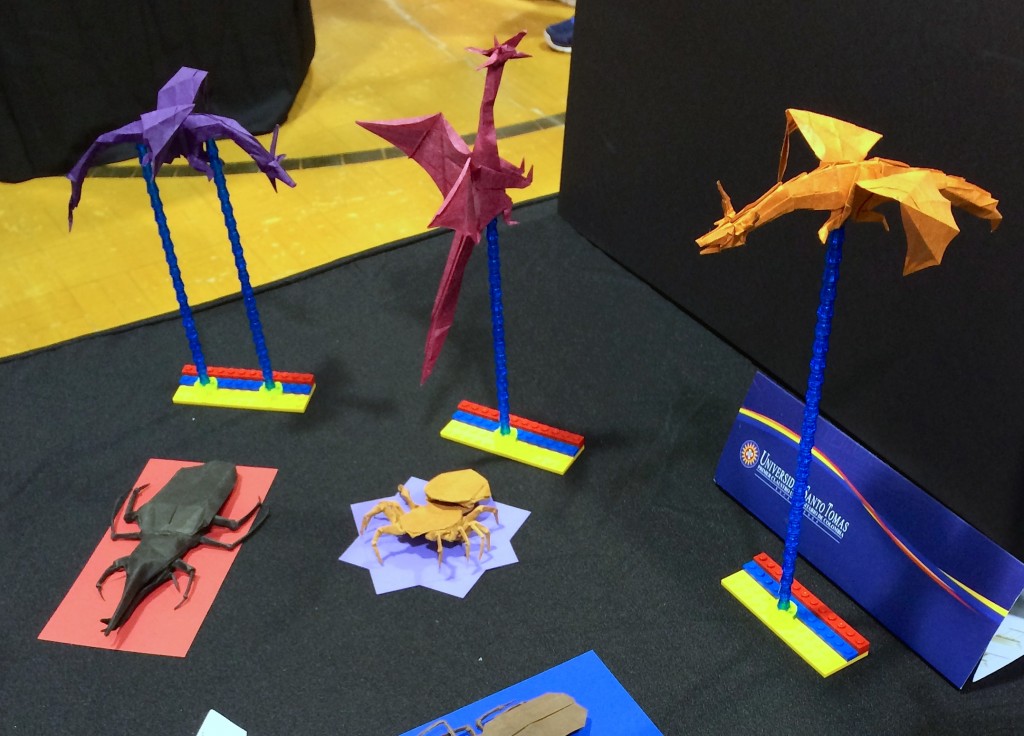
I loved his idea of using Lego® to build bases for his models! The colors of the bases are the colors of the Colombian flag; don’t forget, this was during the World Cup…
Combinando traducción con origami en la convención de OrigamiUSA 2014
Las dos actividades principales de Servimatices Internacional son traducciones y origami. ¡En los últimos días de junio, tuve la oportunidad de combinar las dos en un solo evento!

Siempre que puedo, asisto a la convención anual de OrigamiUSA, que se celebra en Manhattan. El evento, que este año contó con más de 650 participantes activos (no incluyendo adultos que sólo acompañaban a niños), incluye clases, competiciones, una exhibición (de calidad extraordinaria), y muchas oportunidades de convivir con origamistas de todo el mundo. Como muestra de la internacionalidad del evento, una de los invitados especiales este año fue Isa Klein, una origamista brasileña, conocida especialmente por sus modelos modulares y sus videos en las que enseña sus diseños. El otro invitado fue Nick Robinson, maestro y autor prolífico de libros de origami, del Reino Unido.

No hacen falta palabras para compartir el origami – es un arte muy visual, y hay un sistema más o menos uniforme e internacional de símbolos para instrucciones escritas -. Sin embargo, ayuda tener comunicación verbal, especialmente en clases con más de dos o tres personas donde no todos pueden ver de cerca lo que hace el maestro. Por tanto, este año se me ocurrió responder a la convocatoria oficial de intérpretes voluntarios para traducir clases de maestros que no hablan inglés.

Ya tenían dos traductores de portugués a inglés, así que no tuve el gusto de traducir para Isa Klein. Pero les faltaba alguien para ayudar con español, de suerte que acabé traduciendo en vivo una clase dada por Diego Becerra. Diego es un maestro de origami en la Universidad de Santo Tomás en Bucaramanga, Colombia. Aunque es más conocido por sus diseños de insectos, el modelo que Diego enseñó en esa clase fue un dragón. Fue la primera vez en varios años que he hecho traducción simultánea, pero no hubo ninguna dificultad; al contrario, fue una experiencia muy positiva que quiero repetir en otras ocasiones – ¡pude aprender un nuevo modelo de origami y traducir a la vez!
Aquí está una foto de origami que Diego mostró en la exhibición, incluyendo el dragón que enseñó en la clase que traduje :

¡Me fascinó su idea de utilizar Lego® para crear bases para sus modelos!
Club de Origami en el Centro de las Artes
Un club de origami patrocinado por CONARTE está comenzando a reunirse los sábados
en Parque Fundidora, sin costo para los participantes. El club consta de dos grupos:
- Desde las 2PM hasta las 4PM se reúne el grupo de personas con más experiencia, que ya hayan doblado varias figuras y que sepan hacer figuras como el «tsuru». Matthew Green, de Servimatices Internacional, estará presente este sábado (y otros) para compartir sus conocimientos.
- Desde las 4PM hasta las 6PM se reúne el grupo de principiantes, que no necesitan experiencia anterior con el origami.
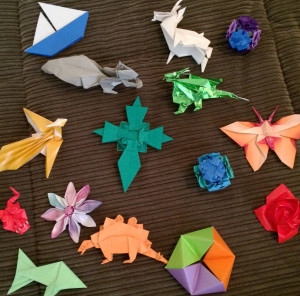 El punto de encuentro para los principiantes es la Biblioteca al Aire Libre del Centro de las Artes (número 12 en este mapa interactiva). El grupo avanzado se reúne en ese mismo lugar a las 2PM para pasar juntos a la Nave Generadores (número 8 en el mismo mapa), porque la entrada a la Nave Generadores es más difícil de encontrar para participantes nuevos.
El punto de encuentro para los principiantes es la Biblioteca al Aire Libre del Centro de las Artes (número 12 en este mapa interactiva). El grupo avanzado se reúne en ese mismo lugar a las 2PM para pasar juntos a la Nave Generadores (número 8 en el mismo mapa), porque la entrada a la Nave Generadores es más difícil de encontrar para participantes nuevos.
CONARTE provee papel tipo «bond» para los participantes sin costo, aunque pueden también utilizar su propio papel especializado de origami.
